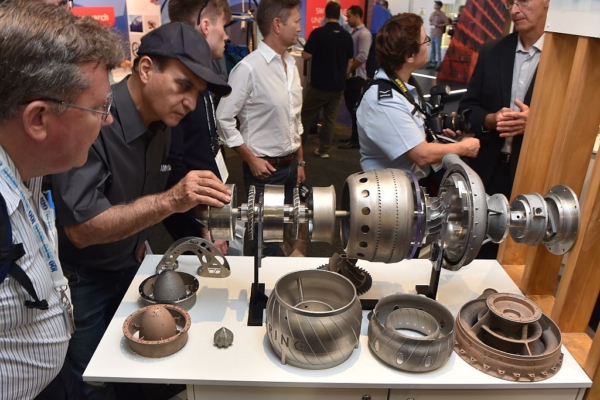In recent years, 3D metal printing has become a new favorite in the aerospace and automotive industries due to its ability to rapidly manufacture complex lightweight parts. However, some metal powders are difficult to use for 3D metal printing. This time, American scientists have found special crystals in alloys that could potentially improve the problem of defects in alloys during printing.
Industries such as aerospace and automotive utilize 3D metal printing to manufacture lightweight parts with intricate geometries, aiming to enhance material efficiency and shorten overall production cycles. However, aluminum and other materials exhibit significant differences in high temperatures and rapid cooling, leading to uneven microstructures and tiny cracks in finished products, severely impacting their mechanical properties and durability.
The National Institute of Standards and Technology (NIST) engineers, led by Andrew Iams, and their team discovered the presence of “quasicrystals” in 3D printed aluminum alloys, a key factor in improving the tendency of aluminum alloys to develop cracks during printing. This discovery holds promise for the research of new aluminum alloys and was published in the Journal Of Alloys And Compounds in April.
During the experiment, the NIST research team observed aluminum-zirconium (Zr) alloy thin slices under an electron microscope to identify the element that enhanced aluminum’s properties, making it printable and robust. The aluminum-zirconium alloy used was developed by a California experimental team in 2017 specifically to address the cracking issues in aluminum 3D printing.
Throughout the process, the NIST team noticed an extremely unusual arrangement of atoms that differed from traditional crystals known in the scientific community but closely resembled the “quasicrystals” previously discovered by Israeli materials scientist Dan Shechtman. Quasicrystals, also known as “quasi-periodic” or “quasiperiodic” crystals, are a special solid state between crystals and non-crystalline solids.
Researchers found that quasicrystals disrupt the regular structure of aluminum crystals, creating more defects in the interior, thus enhancing the metal’s properties. This is attributed to their unique and non-repetitive atomic arrangement that fills the entire metal interstice.
Moreover, these quasicrystals exhibit five-fold rotational symmetry, meaning they appear the same from five different viewing angles while rotating the crystal. Additionally, the quasicrystal demonstrates three-fold and two-fold symmetries when observed from different angles.
Traditional crystal patterns recognized in the scientific community number approximately 230, with crystals composed of atoms or molecules arranged in a repetitive pattern like common table salt. However, due to their perfect structure, traditional crystals have atoms prone to sliding against each other, leading to bending, stretching, or fracturing of objects.
NIST engineer Andrew Iams stated to the NIST newsroom, “Before the discovery, I found it hard to believe that such crystals existed until observing materials under a microscope and realizing I might have found a quasicrystal. The five-fold symmetry is a clear indication of a quasicrystal and is extremely rare.”
Co-author of the paper and NIST physicist Fan Zhang mentioned, “Previously, high-strength aluminum alloys were deemed nearly impossible to successfully print due to cracking issues that rendered them unusable. Thus, we sought to understand the secrets within aluminum-zirconium alloys responsible for solving printing challenges.”
He further stated, “This new finding may pave the way for future alloy designs. Demonstrating that these quasicrystals can enhance the strength of aluminum alloys suggests that people may use these quasicrystals to produce other types of alloy materials in the future.”
Quasicrystals were initially discovered by Israeli materials scientist Dan Shechtman during a vacation at NIST in the 1980s. Many scientists initially questioned his findings, assuming flaws in his research due to the novel crystal shape that defied the dual, triple, quadruple, or hexagonal rotational symmetries of traditional crystals and their formation rules.
However, Shechtman eventually proved the authenticity of quasicrystals, revolutionizing crystallography. In 2011, he was awarded the Nobel Prize in Chemistry for his groundbreaking discovery.
Presently, one of the most common 3D metal printing methods is the “powder bed fusion process,” which involves uniformly layering metal powder and melting it with a powerful laser, repeating the process until the part is complete.
This technology enables the creation of shapes that traditional methods cannot achieve and significantly reduces the weight of finished parts. For instance, General Electric (GE) designed aircraft engine fuel nozzles in 2015 that could only be manufactured through 3D metal printing. The new nozzles not only enhanced engine performance but also reduced weight by 25% and diminished the number of components.
To date, General Electric has printed tens of thousands of such fuel nozzles, showcasing the commercial potential of 3D metal printing.
Nevertheless, current 3D metal printing is limited to a few metal types, and challenges remain in printing aluminum alloys. Ordinary aluminum has a melting point of about 700°C, whereas the laser temperature used in 3D printing far exceeds aluminum’s boiling point of 2,470°C. This causes aluminum metal to heat and cool at a much faster rate than other metals, leading to uneven crystallization and crack formation, significantly affecting the performance of the finished product.
To address the challenges in printing aluminum alloys, HRL Laboratories in California and the University of California, Santa Barbara (UCSB) developed aluminum-zirconium alloy powder in 2017. This aluminum-zirconium alloy forms a robust structure after printing, effectively reducing crack issues.

